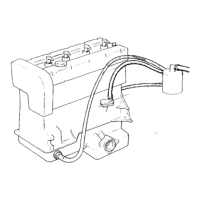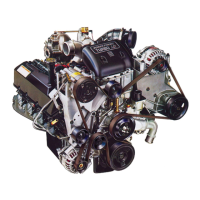04-5 Charging System
04-5
DIAGNOSIS AND TESTING
Preliminary Information
Before performing charging system tests on the engine,
note the complaint such as: slow cranking, battery dead or
using an excessive amount of water, top of battery wet,
ammeter shows charge at all times and/or no charge,
generator warning lamp does not come on and/or never
goes out, voltmeter shows above or below open circuit
nominal voltage. This information will aid in isolating the
part of the system causing the symptom.
Next, visually inspect as follows:
1.
Check battery posts and battery cable terminals for
clean and tight connections. Remove the battery
cables (if corroded), clean and install them securely.
2.
Check for clean and tight wiring connections at the
generator, regulator and engine. Inspect for evidence
of arcing.
3.
Check the generator belt tension using belt tension
gauge T63L-8620-A, Model 210019 or equivalent and
tighten to specification (if necessary).
Isolating the Problem
Battery, starting system, and light systems problems can be
caused by poor charging system performance. It is also
possible to suspect the charging system because of an
overload in another area of the electrical system.
To avoid guesswork, it is necessary to isolate the battery,
the charging system, and the electrical circuits to correctly
identify the area where the difficulty lies. The best method
to do this is to check the battery first before any electrical
system diagnosis. The battery must be in proper state of
charge. The battery must be operating properly before the
other areas of the electrical system can perform normally.
Battery Testing
WARNING: KEEP BATTERIES OUT OF REACH OF
CHILDREN. BATTERIES CONTAIN SULFURIC ACID.
AVOID CONTACT WITH SKIN, EYES OR CLOTHING.
ALSO, SHIELD YOUR EYES WHEN WORKING NEAR
THE BATTERY TO PROTECT AGAINST POSSIBLE
SPLASHING OF THE ACID SOLUTION. IN CASE OF
ACID CONTACT WITH SKIN, EYES, OR CLOTHING,
FLUSH IMMEDIATELY WITH WATER FOR A MINIMUM
OF 15 MINUTES. IF ACID IS SWALLOWED, DRINK
LARGE QUANTITIES OF MILK OR WATER, FOLLOWED
BY MILK OF MAGNESIA, A BEATEN EGG OR
VEGETABLE OIL. CALL A PHYSICIAN IMMEDIATELY.
HYDROGEN AND OXYGEN GASES ARE PRODUCED
DURING NORMAL BATTERY OPERATION. THIS GAS
MIXTURE CAN EXPLODE IF FLAMES, SPARKS OR
LIGHTED TOBACCO ARE BROUGHT NEAR THE
BATTERY. WHEN CHARGING OR USING A BATTERY
IN AN ENCLOSED SPACE, ALWAYS PROVIDE
VENTILATION AND SHIELD YOUR EYES.
WARNING: BATTERIES ARE HEAVY, WEIGHING 30 LBS.
OR MORE. LIFT THEM WITH YOUR LEGS RATHER
THAN YOUR BACK TO PREVENT MUSCLE STRAINS,
AND BE CAREFUL NOT TO DROP THEM (POSSIBLE
BREAKAGE) OR TO SPILL THE CONTENTS (SULFURIC
ACID).
CAUTION: 12-volt starting motors can be damaged
beyond repair if connected to a 24-volt power supply
(two 12-volt batteries in series, or a 24-volt motor-
generator set), even when cranking loads are relatively
light. Extensive starting motor damage is more likely if
the starter is connected to a 24-volt supply while being
subjected to prolonged heavy cranking loads such as
attempting to start an engine in subzero temperature.
Tests are made on a battery to determine the state of
charge and also its capacity or ability to crank an engine.
The ultimate result of these tests is to show that the battery
is good, needs recharging, or must be replaced.
Before attempting to test a battery, it is important to give it a
thorough examination to determine if it has been damaged.
Remove battery cable clamps, negative (-) terminal first.
Check for dirty or corroded connections and loose battery
posts. Remove hold downs and heat shields and inspect
for a broken or cracked case or cover. If the battery is worn
or damaged, if there is a loose or broken post, or if there is
a cracked case or cover, replace the battery.
The battery capacity test should be run next to remove any
surface charge prior to determining the state of charge of a
maintenance free battery.
Capacity Test
A high rate discharge tester (Rotunda Battery-Starter
Tester 02-0204) or equivalent in conjunction with a
voltmeter is used for this test.
4.
5.
Turn the control knob on the Battery-Starter Tester to
the “OFF” position.
Turn the voltmeter selector switch to the 20-volt
position and test selector switch to “AMP”.
Connect both positive test leads to the positive (+)
battery post and both negative leads to the negative
(-) battery post. The voltmeter clips must contact the
battery posts and not the high-rate discharge tester
clips. Unless this is done, the actual battery terminal
voltage will not be indicated.
Turn the load control knob in a clockwise direction
until the ammeter reaches the applicable discharge
rate specified in the discharge rate table.
With the ammeter reading the required load for 15
seconds, note the voltmeter reading. Avoid leaving
the high discharge load on the battery for periods
longer than 15 seconds.
If the voltmeter reading is above the minimum specified in
the table with the test equipment for that temperature, the
battery has a good output capacity and will readily accept a
charge, if required. Check the state of charge.
If the voltage reading obtained during the capacity test is
below the minimum specified in the table, check the state
of charge.

